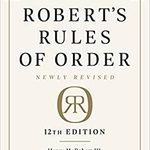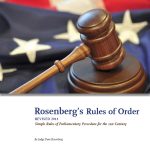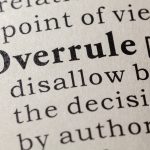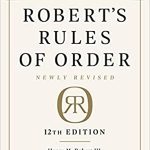Robert’s Rules of Order
Here are the sample minutes provided in Robert’s Rules of Order Newly Revised, 12th edition, in section 48:8. The regular monthly meeting of the L.M. Society was held on Thursday, January 4, 20__, at 8:30 P.M., at the Society’s building, the President being in the chair and the Secretary being present. The minutes of the…
Read MoreUpdated July 11, 2023 Robert’s Rules of Order is quite strict about dealing with something once in a meeting and moving on. If a motion has been defeated, the only way to bring the same motion up again during that meeting is to move to reconsider the motion. You have to have voted with the…
Read MoreIt is a basic principle of parliamentary procedure that the decision of the majority, voting at a properly called meeting, is the decision of the body as a whole. The members whose views did not prevail are bound to go along with the majority. This goes back deep in time, to the origins of our…
Read MoreGuest post by Colette Collier Trohan on how NOT to do things by avoiding action in Robert’s Rules. Many thanks Colette for this useful summary! Have you ever been in a meeting and had the sinking feeling there was no good path forward? If the motion was adopted, perhaps it would inadvertently send the wrong…
Read MoreRosenberg’s Rules of Order is a simplified set of parliamentary rules widely used in California. In many respects it parallels Robert’s Rules of Order. Rosenberg offers an excellent discussion on the role of the chair and the basic format for an agenda item discussion. However, Jurassic Parliament believes that there are several problems with Rosenberg’s…
Read MoreWeldon L. Merritt, PRP, CPP, has graciously authorized Jurassic Parliament to publish this listing of the rights and responsibilities of ordinary members of an organization. All citations are taken from Robert’s Rules of Order Newly Revised, 12th edition (RONR). Download PDF Please note that neither the list of member rights nor the list of member…
Read MoreLocal governments face a tough climate these days. Customs of courtesy have faded and people are often both passionate and rude about their issues. If you are a mayor or presiding officer of a public body, it is critical that you control disorder in your chambers. Council meetings are meetings of the council The basic…
Read MoreA colleague asked for our best tips on leading committee meetings at work using Robert’s Rules. In general, Robert’s Rules don’t apply at work The first and obvious point is that work is not a venue where Robert’s Rules and parliamentary procedure apply. That system of meeting management is designed for assemblies—groups—where all members have…
Read MoreA reader contacted us recently to ask whether the executive committee of his organization had the right to overturn a decision made by the full board. The answer is no, unless the bylaws give that right. Similarly, a board of directors may not overturn a decision made by the full membership. Robert’s Rules is very…
Read MoreUpdated August 26, 2021 Abuse of authority by the chair can be challenging. Here is the guidance from Robert’s Rules of Order Newly Revised, 12th edition. Our blog posts listed below give more information on the practical aspects of dealing with abuse of authority by the chair. Download PDF Remedies for Abuse of Authority by…
Read More










